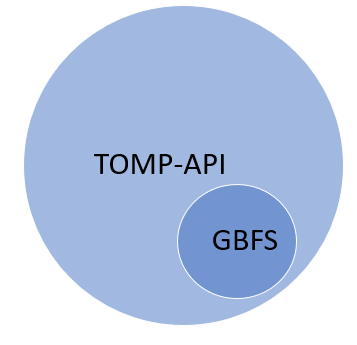We are frequently asked about the relationship between the TOMP-API and several existing standards. In this post, we will clarify how the TOMP-API and GBFS are related.
GBFS
GBFS is in use for quite a while now. It has a large base of organizations that are more or less using it. The majority of the (public) implementations are completed to a basic level.
It’s used in 45+ countries to create public data for over 450+ shared mobility systems. It was initially designed to support publicly available standardized data about shared mobility service offerings.
GBFS consists of files that are published in a public place. In a lot of cases, the implication is limited to only the basic files (general information, sometimes stations, sometimes availabilities), which does not include all data that is required to set up a full implementation.
Therefore a lot of MaaS providers who need this data, make individual arrangements with these bike operators and implement a complete set of files somewhere in a non-public location.
It was also not designed for private fields, such as the vehicle status or the battery level, so MaaS Providers often used a customized version of GBFS.
GBFS adoption
As the TOMP working group, we were convinced that this GBFS standard is a good starting point, so we took the GBFS description, transformed it to a web service format, and extended it:
- we added paging (for big datasets, like available-assets) with limit & offset parameters
- we added some server-side filter options (like stations within a region or available assets within a station)
- we added geographical information: the regions are extended with a polygon, describing the region
- some other fields, like the Chamber of Commerce, product type, and class of assets (in GBFS this is of course not an issue, it’s always ‘BIKE’)
Actually, you could say we are covering the complete GBFS standard. For easy, file-based, implementation of the GBFS standard is very valuable for communicating information from Bike Operator to MaaS provider, but when aiming for a full MaaS integration, you’ll need the TOMP-API.

The future of GBFS
Whenever GBFS makes extensions, we’ll take a good look at it. Lately, GBFS 2.0 was released, containing URIs for deep links. We have added them also in the TOMP-API, despite it is actually against the vision of the TOMP workgroup, where deep linking shouldn’t be needed in the future. But nowadays it is often the only technical solution, so we decided to add these fields in the TOMP-API 1.1.0.
We see that MobilityData (http://mobilitydata.org/), the organization is working on the extension GBFS-Private. We – as TOMP working group – will cooperate together with MobilityData, trying to align with the intention of reducing the burdens on data producers and consumers.
